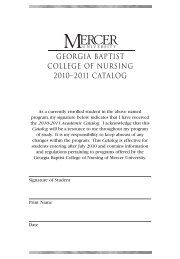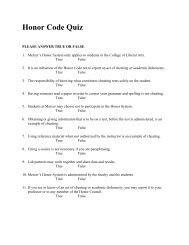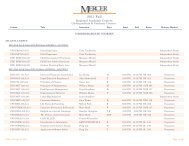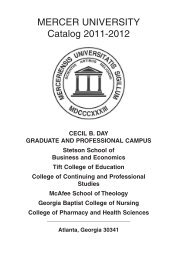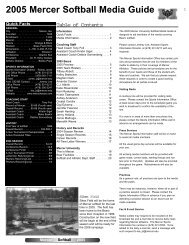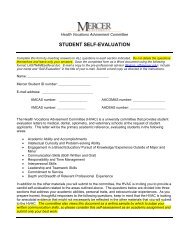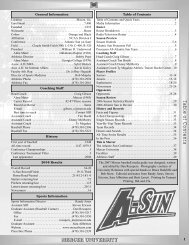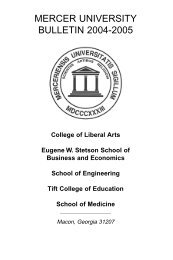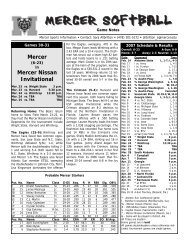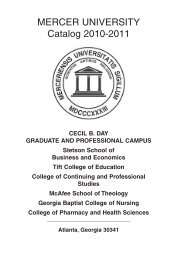2006-2007 Regional Centers Catalog - Mercer University
2006-2007 Regional Centers Catalog - Mercer University
2006-2007 Regional Centers Catalog - Mercer University
Create successful ePaper yourself
Turn your PDF publications into a flip-book with our unique Google optimized e-Paper software.
• To encourage the enrollment of qualified persons from diverse backgroundsand situations• To contribute campus resources, in partnership with other institutionsand agencies, to improve the educational, social, and economic developmentof the community• To administer services efficiently and effectively to support the<strong>University</strong>’s instructional, research, and public service programs<strong>University</strong>-Wide Assessment<strong>Mercer</strong> <strong>University</strong> conducts a university-wide assessment program to measurestudent progress toward educational goals, to evaluate academic programs,to improve learning and teaching, and to evaluate institutional effectiveness.Students are active participants in a variety of campus-based assessmentactivities that focus on attitudes, satisfaction, and academic achievement. It isthrough student participation in the assessment process that the <strong>University</strong> canbetter understand itself and better serve its constituents.<strong>University</strong> History<strong>Mercer</strong> <strong>University</strong> first opened its doors as <strong>Mercer</strong> Institute on January 14,1833, at Penfield, Greene County, Georgia. It is named for Jesse <strong>Mercer</strong> (1769-1841), an eminent Georgian, distinguished Baptist clergyman, and principalorganizer of the Georgia Baptist Convention. Establishment of <strong>Mercer</strong> Institutewas due largely to his leadership and to the exemplary pioneering of AdielSherwood, a noted Baptist minister and, later, a faculty member. In 1871, the<strong>University</strong> was moved from Penfield to Macon, and, two years later, the LawSchool was established.Early in the administration of Spright Dowell, which began in 1928, a newcharter was approved, and the corresponding reorganization was perfected.Significant growth of the <strong>University</strong> ensued. Before President Dowell retired in1953 to the position of president emeritus, the plant and property and endowmentof the <strong>University</strong> had been increased more than in all of its previous years.A more complete account of <strong>Mercer</strong>’s history may be found in the latePresident Spright Dowell’s A History of <strong>Mercer</strong> <strong>University</strong>, 1833-1953, publishedby <strong>Mercer</strong> <strong>University</strong>, 1958.Chosen as Dr. Dowell’s successor was George B. Connell, a 1924 graduatewho had served six years as vice president. During Dr. Connell’s term of office,from 1953 until his death on April 21, 1959, substantial strides were madethroughout the <strong>University</strong>, including important new construction and the additionof approximately $1.5 million to the endowment fund.Emeritus President Dowell, who had remained active in the service of the<strong>University</strong> during his retirement by writing a history of <strong>Mercer</strong>, was appointed bythe Board of Trustees as interim president following Dr. Connell’s death. Dr.Dowell served until the succeeding president could assume office in April 1960.During his interim, the formerly independent Southern College of Pharmacy inAtlanta, founded in 1903, merged with the <strong>University</strong>. Dr. Dowell died onFebruary 24, 1963.On November 6, 1959, the Board of Trustees elected Dr. Rufus CarrolltonHarris, president of Tulane <strong>University</strong>, to the <strong>Mercer</strong> presidency. Dr. Harris, a8 / MERCER UNIVERSITY



